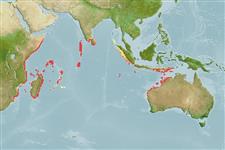>
Blenniiformes (Blennies) >
Blenniidae (Combtooth blennies) > Salariinae
Etymology: Cirripectes: Latin, cirrus = curl fringe + Greek, pektos, -e, -on = made of several parts solidly united (Ref. 45335); gilberti: Named after Dr. Carter R. Gilbert (FSM)..
Environment: milieu / climate zone / depth range / distribution range
Écologie
marin récifal; profondeur 0 - 8 m (Ref. 529). Tropical; 10°N - 30°S
Indian Ocean: South Africa, Comoro Islands, Agalega Islands, Seychelles, Chagos Archipelago, Cocos-Keeling Islands, Christmas Islands, and the northern tip of Sumatra.
Length at first maturity / Taille / Poids / Âge
Maturity: Lm ?, range 8 - ? cm
Max length : 10.2 cm SL mâle / non sexé; (Ref. 529)
Description synthétique
Morphologie | Morphométrie
Épines dorsales (Total): 12; Rayons mous dorsaux (Total): 14; Épines anales 2; Rayons mous anaux: 15; Vertèbres: 30. Diagnosis: Dorsal fin XII, 14, membrane attached to caudal fin, with deep notch above last spine, first spine almost same or slightly higher than second; anal fin II, 15; pectoral rays 15; pelvic fin I, 4; caudal fin procurrent rays 11-14. Vertebrae 10 + 20. LL, without scales and scalelike flaps; LL tubes 0-3 (sometimes up to 5), canal ends below posterior to 9th dorsal ray, usually on caudal-fin base. Lower lip smooth mesially, plicate laterally. Upper lip crenulae 36-48. Gill rakers 24-30. Cephalic sensory pore system complex. Cirri, nuchal 50-64, supraorbital 17-48, nasal 11-37; nuchal cirri in 4 groups, where 2 or 3 groups are occasionally connected basally by a slightly notched frenum, usually dorsalmost groups overlap at middle of nape, ventralmost group on each side on expanded nuchal flaps. Body depth at anal-fin origin 3.0-3.8 in SL. Adult males with brown body; females greyish brown with red spots in life (Ref. 529, 90102).
Facultative air-breathing in the genus (Ref. 126274); Adults occur on rocky and coralline substrates at depths from near surface to 8 m (Ref. 529). Oviparous. Eggs are demersal and adhesive (Ref. 205), and are attached to the substrate via a filamentous, adhesive pad or pedestal (Ref. 94114). Larvae are planktonic, often found in shallow, coastal waters (Ref. 94114).
Oviparous, distinct pairing (Ref. 205). Urogenital orifice of male genital papilla located basally between 2 widely separated slender filaments on a fleshy swelling behind anus; testes bulbous with length equal to its width (Ref. 529).
Williams, J.T., 1988. Revision and phylogenetic relationships of the blenniid fish genus Cirripectes. Indo-Pac. Fish. (17):78 p. (Ref. 529)
Statut dans la liste rouge de l'IUCN (Ref. 130435)
Menace pour l'homme
Harmless
Utilisations par l'homme
Pêcheries: sans intérêt
Plus d'informations
Taille/ÂgeCroissanceLongueur-poidsLongueur-longueurFréquences de longueursMorphométrieMorphologieLarvesDynamique des populations larvairesRecrutementAbondanceBRUVS
RéférencesAquacultureProfil d'aquacultureSouchesGénétiqueElectrophoresesHéritabilitéPathologiesTraitementNutrientsMass conversion
CollaborateursImagesStamps, Coins Misc.SonsCiguateraVitesseType de nageSurface branchialeOtolithesCerveauxVision
Outils
Articles particuliers
Télécharger en XML
Sources Internet
Estimates based on models
Preferred temperature (Ref.
123201): 25.2 - 28.9, mean 27.9 °C (based on 533 cells).
Phylogenetic diversity index (Ref.
82804): PD
50 = 0.5000 [Uniqueness, from 0.5 = low to 2.0 = high].
Bayesian length-weight: a=0.01072 (0.00480 - 0.02393), b=3.01 (2.82 - 3.20), in cm total length, based on LWR estimates for this (Sub)family-body shape (Ref.
93245).
Niveau trophique (Ref.
69278): 2.0 ±0.00 se; based on food items.
Résilience (Ref.
120179): Haut, temps minimum de doublement de population inférieur à 15 mois (Preliminary K or Fecundity.).
Fishing Vulnerability (Ref.
59153): Low vulnerability (10 of 100).
